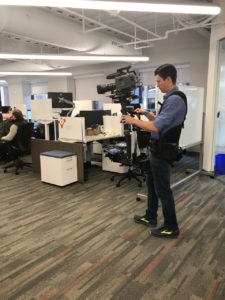Mastering B-Roll in Video Production: Techniques and Tip
B-roll is supplemental footage that should be driving home certain creative points in your video’s narrative.
For example, in an interview, the footage of the talent is called a talking head, and the footage you see play over the interview is that supplemental footage.
B-roll could be considered the “beauty” shots. Say the interview is about a product that your company is developing; the b-roll would be about that product specifically.
The actual term came from back in the old days when film reels were used. Back then, when editing footage, there were these things called video decks.
On each deck, you have a roll of tape, so the first deck would be called Roll A, and this roll would be the interview itself. So the second roll, or the B-roll, was technically a second editing deck.
Think of it this way: the A-roll is all interview content and talking head content. The B-roll is all the supplemental footage that should be directly connected with what is being said in the interview.
However, B-roll can be creative and doesn’t have to be so literal. It’s there to liven up the video and pique the viewers’ interest, as well as to visually explain the product or service your company is advertising.
Simply put, B-roll is footage captured that is above and beyond your interview.
Table of Contents
Be Intentional With B-Roll
B-roll should always have a purpose. Every shot in a video should have meaning. As Skillman Video Groups’ CEO and Creative Director, Christina Skillman says, “Nothing is by accident; all is by design.”
This means that every shot you take, even if it doesn’t make it into the final video, should serve a purpose and launch the video further towards its goal.
It’s important to remember because if a shot does not serve a purpose, multiple things could happen, such as the viewer losing interest, becoming confused, etc. It’s always better to have a shot that actually makes sense to the viewer, so you keep them engaged.
Steps to Good B-roll
One of the first steps in creating a good b-roll is to have a good pre-production process. You want to talk about who you’re going to interview, as well as where and how you want to shoot the interview.
The other part of the shoot date is going to be shooting that supplemental footage, the b-roll, that should be driving home the key messages in your video content.
Try to always get your own proprietary footage taken. This could include footage of employees working in their offices, the making or building of your product, the product being used out in the field, or interactions between you and your client.
What’s the point?
The whole point of b-roll is to bring the video, your company, and your brand to life and make the audience feel like they have a connection to your brand.
Being intentional with the b-roll is not limited to what occurs in the video in terms of action. What’s just as important is how you shoot the b-roll. There are endless possibilities for how to hold a camera and how to move it. For example, a shoulder mount can be shaky, which might not be as attractive as opposed to, say, a Steadicam.
Steadicams are one of the many ways to move a camera to get a beautiful shot. They keep the camera steady and make fluid motions, so the video is smooth.
Other techniques include sliders or tripods. And each technique should have a purpose when being used. Tripods are stationary, whereas sliders move the camera on a level surface, to the side, or forward and backward.
You want to be intentional with the technique you use because each one portrays different emotions. Shoulder mounted and shaky could mean something is intense or suspenseful, and a Steadicam could portray calmness.
You want camera movements and angles to assist the visuals and not distract from them.
Stock Footage (is it okay to use, and in what situations is it okay to use it)
But what if you can’t get the necessary b-roll? You can use stock footage.
Many websites sell or license out footage to be used by anyone. Many people think that using stock footage is inauthentic, which is not completely true or false.
There are times when you should use it and times when you shouldn’t.
A couple of dos and don’ts of stock footage
Do use it if it does not make financial sense to send a crew to capture the footage you need. An example of this could be oil. If you’re creating a video about oil in general and need footage of an oil rig or wells, it does not make sense to send a crew out into the ocean for footage of an oil rig when there are thousands of clips of exactly what you need that you can download with a click of a button.
Don’t use stock footage if you need footage of a brand-specific product, place, or service. The audience wants to see your brand and your company. Showing them footage that they could potentially see in another company’s video limits the connection they will have to your brand. This is when the inauthentic piece to stock footage comes in.
Stock footage should be used for extremely general clips. Such as establishing shots that you may not have the resources to get, like the New York Skyline, oil rigs, deserts, etc.
If you do not have the time or resources to get a shot, that is when it is acceptable to use stock footage. Again, everything is permissible as long as it is intentional.
Whether you use stock footage in your video or you actually invest to have a crew come and get proprietary footage, there’s a right or wrong answer. It’s only right or wrong, depending on what the intention is for your video.
Conclusion
B-roll is just as important as an interview. There are multiple ways to obtain the b-roll that is right for you, whether it’s using drones, tripods, sliders, or stock footage. It’s what your audience will see and interpret as part of the story, so you want it to impact them in some way.
There are always creative ways to get the images that you want. Everything in your video communicates something about you, your product, and who you are as an organization.
Frequently Asked Questions
What is B-roll, and why is it important in video production?
B-roll is supplemental footage that supports and enhances the main narrative of your video.
It can include beauty shots, action sequences, or detailed visuals related to the topic. B-Roll helps keep the audience engaged by providing visual variety and context, making the content more dynamic and visually appealing.
It also adds depth to the story, helping to visually explain and emphasize key points in the interview or main footage. By intentionally using B-roll, you can create a more polished and professional video that resonates with viewers.
How can I be intentional with my B-roll footage?
Being intentional with B-roll footage starts with a solid pre-production plan.
Identify the key messages you want to convey and think about how supplemental footage can enhance these points. Plan your shots carefully, ensuring each one serves a specific purpose and aligns with the overall narrative.
Utilize various camera techniques, like Steadicams for smooth shots or shoulder mounts for a more intense feel. Each shot should contribute to the story, keeping viewers engaged and making the video more cohesive and compelling.
What are some techniques for shooting effective B-roll?
Effective B-roll shooting techniques include using different types of camera mounts and movements to convey specific emotions and enhance the visual story.
Steadicams provide smooth, fluid motions, making them ideal for calm or professional scenes. Sliders can create dynamic side-to-side or forward-backward movements, adding depth and interest. Tripods offer stable, stationary shots that are perfect for establishing scenes or interviews.
Experiment with angles and movements to find what best suits the mood and message of your video, ensuring that each shot enhances rather than distracts from the narrative.
When is it appropriate to use stock footage for B-roll?
Stock footage is appropriate when it is not feasible or cost-effective to capture the necessary footage yourself.
Use it for general shots that do not need to be brand-specific, such as landscapes, cityscapes, or industry-specific visuals like oil rigs. Stock footage can save time and resources while still providing high-quality visuals for your video.
However, avoid using stock footage for unique or branded content, as it can feel inauthentic and reduce the connection between your audience and your brand. Always ensure that the stock footage you choose aligns with the intended message and aesthetic of your video.
How can I ensure my B-roll footage enhances the overall video narrative?
To ensure your B-roll enhances the video narrative, start by aligning it with the key points and themes of your main footage.
Each shot should have a clear purpose and contribute to the story you’re telling. Pay attention to the technical aspects such as lighting, composition, and camera movement to maintain a high production value.
Use B-roll to visually explain concepts, show processes, or add context to the main content. By thoughtfully integrating B-roll, you can create a more engaging, informative, and visually appealing video that effectively communicates your message.
Share:
Search our blog:
Follow us on:


